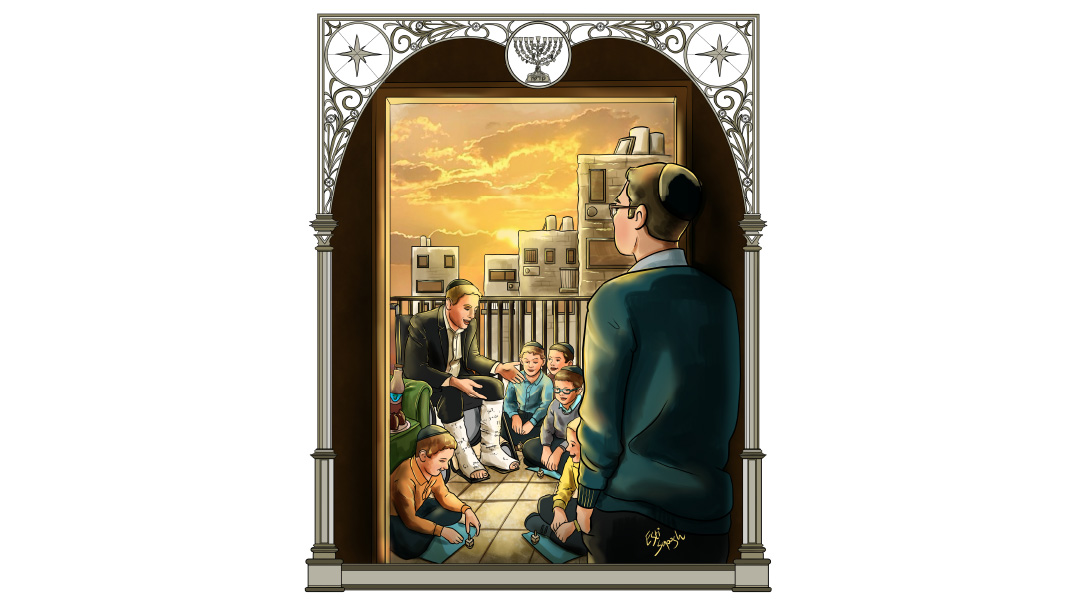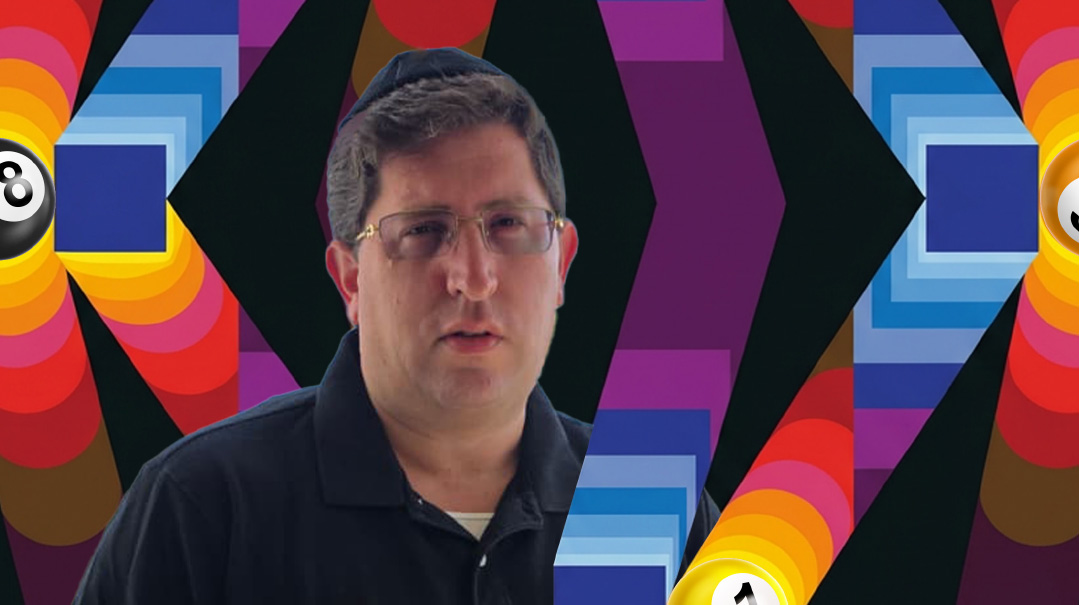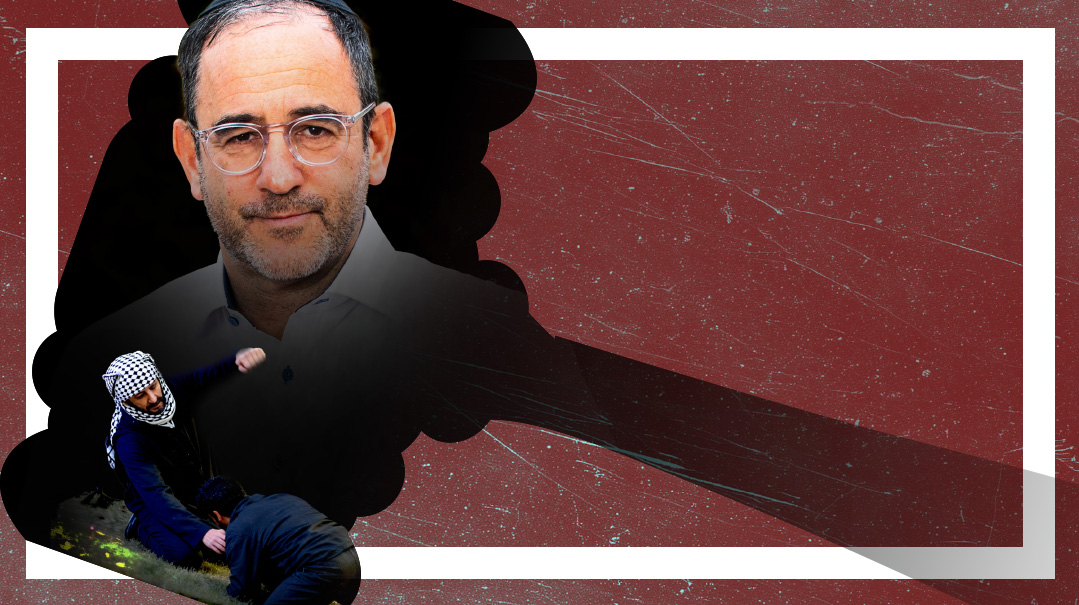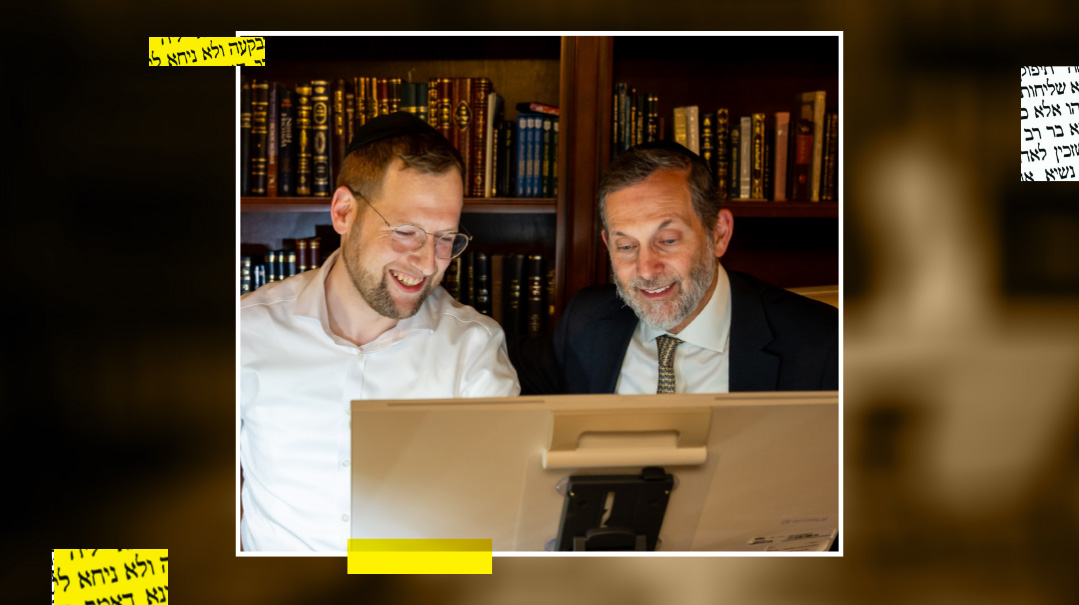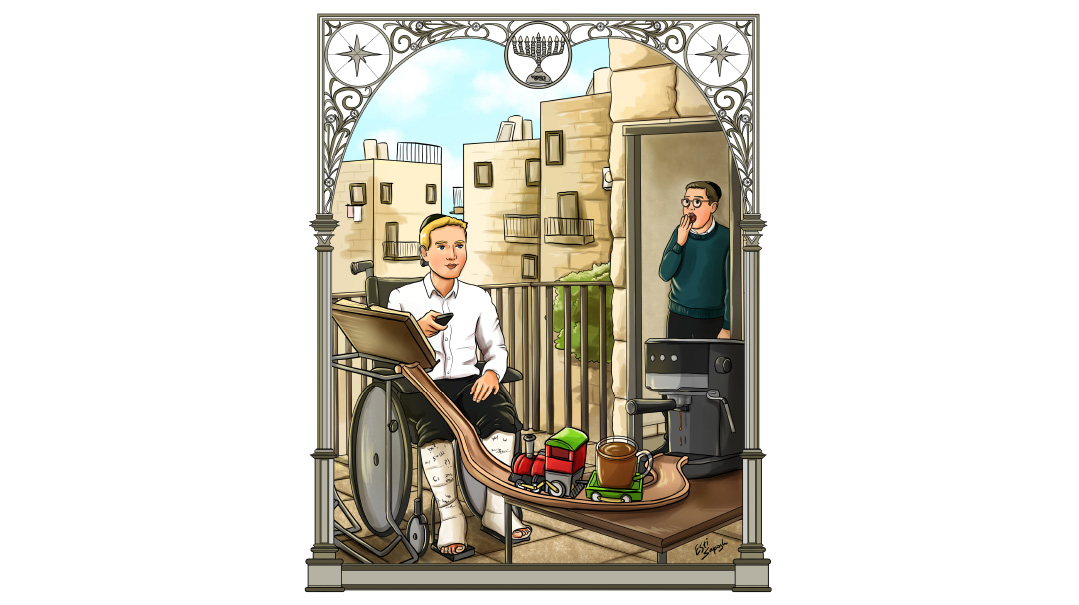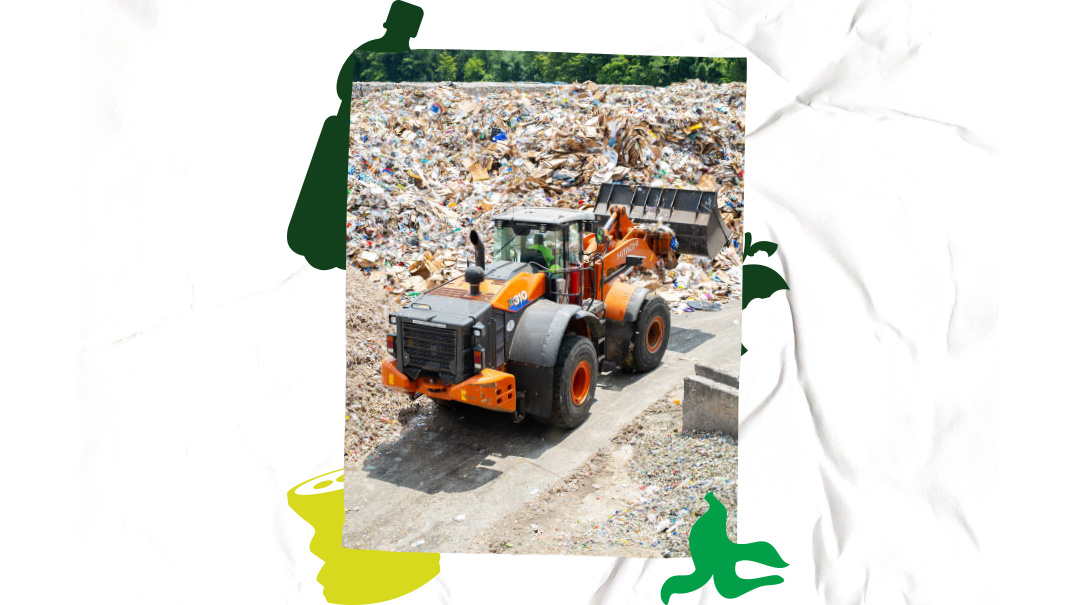Tears to Awaken

Oorah founder Rabbi Chaim Mintz doesn't let your soul go to sleep
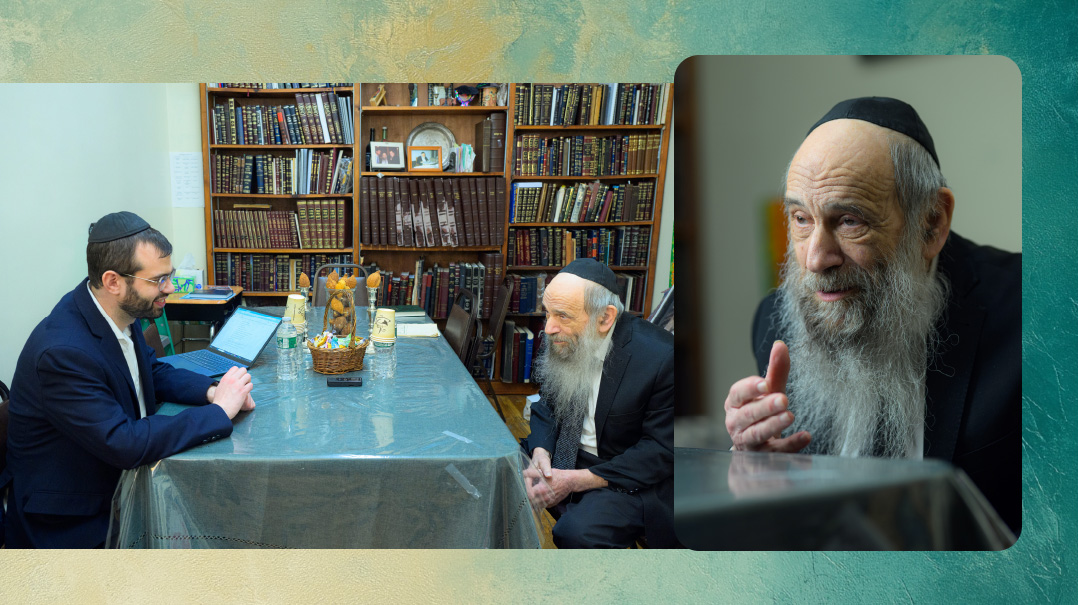
Photos: Naftoli Goldgrab, Family archives
With insights from his own great rebbeim, Rabbi Chaim Mintz, who would go on to found Oorah, became a beloved mashgiach at the Yeshiva of Staten Island. But that was only the beginning. Reading a line about how Jews have an achrayus to help those distant from Torah, he looked around and said, ‘Nu? What are we doing for all the secular Jews?” The bochurim looked back at their rebbi. “There’s nothing we can do!” To which Rabbi Mintz responded, “You wanna bet?”
Rav Dovid Kronglas ztz”l, seldom cried. As the legendary mashgiach of Yeshivas Ner Yisroel Baltimore, his shmuessen were aflame with fiery passion, and at times, interlaced with humor as well.
But he didn’t cry.
When Elul came, the talmidim knew to expect the sudden transformation that would overcome their mashgiach. Fear would envelop him, he would hardly speak, and he never smiled. He gave more shmuessen than usual, and, with fiery passion and heartfelt emotion, he would speak about eimas hadin — the fear of judgment.
And still, he didn’t cry.
Rosh Hashanah arrived and he rose to stand before the amud. Cloaked in a tallis, his face the picture of fear, he began to recite Kaddish. Yisgadel v’yiskadash Shmei rabbah! May Your Great Name grow exalted and be sanctified. And suddenly, his voice would crack.
And Rav Dovid Kronglas cried.
The talmidim shuddered as they continued to daven, inspired and uplifted by their rebbi’s tefillos.
One talmid never forgot that cry. Chaim Mintz hailed from Scranton, Pennsylvania, and joined the yeshivah at the age of 13. He diligently attended Rav Dovid’s shmuessen. In fact, he missed only one shmuess in his seven years at the yeshivah — and that was because he was sitting shivah for his father. He learned a tremendous amount from Rav Dovid, gaining a mehalach halimud both in learning and hashkafah.
But most of all, he learned that yisgadel v’yiskadash Shmei rabbah is something to cry about.
IN
time, Chaim graduated from Ner Yisroel and became a rebbi, first in the yeshivah’s newly founded branch in Toronto, and then in Yeshiva of Staten Island. This led to a broader role as Chaim, now revered as Rav Chaim, assumed the position of mashgiach ruchani, mentoring hundreds of talmidim, both past and present.
Simultaneously, Rabbi Mintz embarked on a humble but impassioned mission to reach beyond the walls of the yeshivah — to those who never had a chance to dwell within its confines. This included endeavors such as sending special packages each Chanukah to the Jewish neighbors, imploring unaffiliated Jews he’d meet to send their children to Jewish schools, and arranging chavrusashafts between less affiliated Jews and talmidim of the yeshivah.
Over time, the various initiatives snowballed into what is now a behemoth kiruv organization: Oorah.
Oorah’s impact in the kiruv world is literally incalculable. Its two summer camps, one for boys and one for girls — collectively called The Zone — welcome some 1,500 campers annually. In addition to summer camp, Oorah runs kiruv programs throughout the year and operates numerous kiruv resources utilized by thousands of Jews around the globe. Their tuition assistance program funds the tuitions of over 2,300 children, enabling them to attend Jewish schools and receive a Jewish education.
Some 6,300 chavrusashafts are currently facilitated through Oorah’s TorahMates program, which links less knowledgeable Jews with those privileged to have had a Torah education. The pairs then schedule regular learning sessions with each other.
In a sense, the tuition assistance program and TorahMates work in tandem. As part of the deal Oorah strikes with parents, the funding of their child’s tuition is contingent on their agreeing to learn with a TorahMate. This arrangement fosters a dynamic of joint growth as both parents and children develop in their Jewish knowledge.
Rabbi Mintz’s lifework is divided into two primary focuses.
He is the mashgiach of Yeshiva of Staten Island where he mentors bochurim as they navigate through their years in a top-level yeshivah.
He is the manhig ruchani, the spiritual director, of Oorah where he has the last say on the many critical decisions that are made in the framework of such a massive kiruv enterprise.
The two positions may seem to have little in common but Rabbi Mintz doesn’t see it that way.
In his mind, the two share an objective. Sixty years after it was emitted, Rav Kronglas’s cry continues to reverberate.
Yisgadel v’yiskadesh Shmei rabbah.
It all falls under the same banner.
T
he Yeshiva of Staten Island is an imposing edifice situated at the center of a sizable campus, shrouded from view by a line of towering trees. Four enormous white pillars stand at the building’s entranceway. But take one step past the simple set of doors and any sense of intimidation dissipates. The familiar clang of locker doors slamming shut, rapid footsteps charging down a hallway, and the faint but wonderful sound of dozens of talmidim learning in the beis medrash blend together in a very familiar harmony.
A bochur directs me to Rabbi Mintz’s office, whose plain door is closed. For some reason, while preparing to knock, the sense of intimidation begins creeping in once again. After all, the man behind this door has launched a kiruv revolution, transformed thousands of lives, and enabled millions of futures.
I knock, the door opens, and at once, the intimidation disappears again. From the first shalom aleichem, it is clear that ego and self-interest do not exist in the simple, unadorned office of Rav Chaim Mintz.
“We grew up in Scranton, Pennsylvania,” Rabbi Mintz says. “There was no Jewish school there at the time. I went to public school until sixth grade.” Rabbi Mintz, his brother, and two sisters, were far from the only Jewish students in the Scranton public school. “Nearly ninety percent of the students were Jewish,” he recalls. “Very few, however, were frum.” That’s not to say that there was no exposure to frum life. The rav of the shul was a Slabodka talmid named Rav Elchanan Tzvi Gutterman — with whom Rabbi Mintz was very close — and there were many in the community who closed their shops and businesses on Shabbos. But with limited frum educational opportunities and infrastructure, hopes for raising another generation of observant Jews there were dismal.
In the Mintz home, however, inspiration was part of the family heritage.
“My father was a businessman,” Rabbi Mintz shares, “but Shabbos was the focal point of our lives. Our Friday night meal would go on for hours, as my father sang beautiful niggunim.”
It was this sense of passion that led the family to Scranton in the first place.
“My grandfather left Poland before World War I,” says Rabbi Mintz. “He first settled in Boston where he was employed as a shochet. He was then hired to work as a shochet in Bangor, Maine.”
But then he was approached by members of the Bangor community who expressed displeasure with his appearance. “Rabbi Mintz,” they said, “here in America, you don’t need a beard. You should shave it off.”
“When my grandfather heard that they wanted him to shave off his beard, he told my grandmother that they could no longer live there. They picked up and moved to Scranton.” This act of mesirus nefesh may have engendered generations of commitment to Torah and Yiddishkeit, but in truth, the blessing was set in motion several years prior. “My grandfather was an Aleksander chassid,” says Rabbi Mintz. “When he was considering moving to America, he consulted with the Gerrer Rebbe, the Imrei Emes, who told him, ‘Go. Your children will remain frum.’”
While Rabbi Mintz was still in public school, a Jewish day school opened up and, when he reached sixth grade, he transferred to the new school. “I attended the day school for sixth and seventh grade and then my parents sent me to Baltimore to learn in Ner Yisroel.”
IT
was in Ner Yisroel that he met Rav Dovid Kronglas for the first time. “To be an eved Hashem was Rav Dovid’s whole emphasis,” says Rabbi Mintz. This was expressed through his many shmuessen but also through his very existence. “Anyone who didn’t see Rav Dovid’s Elul and Yamim Noraim hasn’t truly seen an Elul and Yamim Noraim in their lives,” Rabbi Mintz posits.
Rav Dovid was a student of the Mir and a protege of its great mashgiach, Rav Yerucham Levovitz ztz”l. But while this background suggests a strictly litvish discipline, Rav Dovid didn’t shy away from openly discussing more esoteric elements of Torah as well. “He gave shiurim in Nefesh Hachaim, Daas Tevunos, and Derech Hashem,” Rabbi Mintz relates.
In recent years, through Oorah’s “Ask the Rabbi” sessions, these lessons have been spread to thousands around the globe.
“Ask the Rabbi” is a weekly program in which Rabbi Mintz fields questions from all over the world, about any Torah-related topic. About four years ago, the content of these sessions was compiled into a book entitled Ask the Rabbi, published by Artscroll/Mesorah. The book’s popularity encouraged Oorah to continue publishing Rabbi Mintz’s insights and, earlier this year, Ask the Rabbi 2 was released, also by Artscroll/Mesorah.
“The hashkafos of the book are all primarily based on the yesodos I heard from Rav Dovid,” says Rabbi Mintz. The very first question in the book goes directly to the theme that Rav Dovid spent a lifetime emphasizing.
The last mishnah in Avos states that everything in the world was created for Hashem’s honor. We also know that our entire purpose in this world is to serve Hashem. Isn’t it selfish of G-d to create the world entirely for His own benefit?
Rabbi Mintz begins his answer by dispelling a basic misperception.
This question is based on a fundamental misunderstanding. Hashem is the epitome of perfection and completely self-sufficient. He doesn’t need anything from anyone, and He doesn’t gain anything from our service and honor. Everything we do in this world to serve and honor Him is purely for our benefit.
He then points to the first chapter of sefer Mesillas Yesharim, which puts things into the proper perspective.
As the Mesillas Yesharim writes at the very beginning of his classic work, Hashem created us so we can be close to Him. He is the Source of all enjoyment, and closeness to Him is the greatest pleasure attainable. The ultimate place to connect to Hashem and experience this pleasure is in the World to Come, but it is in this world that we can work to earn this great reward. By perfecting our character and performing mitzvos here, we become worthy of reaping the fruits of our labor and meriting eternal reward in the World to Come.
And then, true to his rebbi’s influence, he quotes an idea from the Derech Hashem.
In his sefer Derech Hashem, Ramchal adds that the reason Hashem didn’t just place us directly in the World to Come is because we would have felt the shame of someone receiving a handout. It is only through earning this closeness that we can experience the optimum pleasure of the World to Come. Thus, when we honor and serve Hashem, it is we who gain. The more we recognize Him and draw close to Him, the more we can connect to Him for eternity.
It is the perfect preface to a book that imparts Rav Dovid Kronglas’s life lessons. “When we honor and serve Hashem it is we who gain, through the cry of yisgadel v’yiskadesh we grow closer, better, happier.”
R
av Dovid’s mussar could be extremely demanding. “I get credit for one of his shmuessen,” Rabbi Mintz smiles. “I was sitting near him at Shalosh Seudos. I made a hamotzi and ate a piece of challah. Then I paused eating. On the table was some fish and cherry pie. Rav Dovid looked at me and said, ‘Mintz — farvos est du nisht?’ (Why are you not eating?) So I took a piece of cherry pie, ignoring the fish. That week, Rav Dovid gave a fiery shmuess about indulging in ta’avos.”
Ironically, one of the questions in the newly released book addresses the emphasis our tradition places on eating fish on Shabbos.
Question 98 is: I have noticed that fish is usually served at traditional Shabbos meals. Is there something special about fish? And what if I don’t particularly enjoy fish, should I still make sure to have some?
Rabbi Mintz begins by providing the simplest answer, which is that fish is a delicacy and thus enhances oneg Shabbos. He then shares a much deeper idea.
However, on a deeper level, there is something very unique about fish. Since humans and animals are unable to live in water, life in the water is like life in a different world. For this reason, we find that although the animals all perished in the Great Flood (Mabul), the fish did not. The evil and immorality of the people at that time contaminated the world’s very atmosphere, affecting even the animals and making them unfit to remain alive. The fish, however, existing in their own world, remained pure and unaffected by the contamination of the world, and thus survived the Flood.
The fish lived in their own world, separate and apart from a realm whose moral fabric is steadily unraveling. Shabbos as well, explains Rabbi Mintz, is a temporal existence whose sanctity dictates a detached and elevated reality.
This is one reason why it is customary to eat fish on Shabbos. Shabbos is m’ein Olam Haba, a semblance of the eternal life in the World to Come, and on this day we refrain from work, leaving behind the mundane and connecting to Hashem. Since fish live in the water and are “out of this world,” it is an appropriate dish for the day we live on a higher sphere. We then strive to keep this lesson with us throughout the week, inspired to live a more spiritual existence.
Although Rav Dovid was a serious person, being in his presence did not evoke burdensome intensity. Rabbi Mintz shares a humorous anecdote.
“In a shmuess, Rav Dovid once said, ‘I don’t say chasiddishe vertlach. But I’ll say one chassidishe vert’l. Why do we have two eyes? One to see the maalos of others, the other to see our own chesronos.’ On Purim that year, the bochurim put on a skit. One chasiddishe bochur got up and said, ‘I don’t say litvishe vertlach, but one litvishe vert’l I’ll say. Why do we have two ears? One to hear one tzad, the other to hear the other tzad.’ ”
Rabbi Mintz attended Rav Dovid’s shmuessen diligently, in addition to joining his shiur once he reached the fourth year of beis medrash.
R
av Kronglas wasn’t the only one to leave an indelible impression on a young Chaim Mintz. Rav Yaakov Moshe Kulefsky was a much beloved maggid shiur in Ner Yisroel before becoming its rosh yeshivah. “Rav Kulefsky gave the shiur to the third year bochurim,” says Rabbi Mintz, “and he would speak to us in learning for hours. I consider him my rebbi in lomdus.”
And then of course, there was the venerated rosh yeshivah, Rav Yaakov Yitzchak Ruderman ztz”l, who would also become one of Rabbi Mintz’s great rebbeim. This relationship, however, did not fully develop until after Rabbi Mintz had left the yeshivah.
“The community in Toronto had reached out to Ner Yisroel and requested help in establishing a branch in Toronto,” says Rabbi Mintz. “I was one of ten bochurim who went as that initial group.”
Rav Shalom Gold and Rav Gershon Weiss were appointed to lead the fledgling yeshivah. Rabbi Mintz remained there for seven years and it was during this time that he became exceptionally close with Rav Ruderman. “Rav Ruderman would come to Toronto to visit the yeshivah. I was meshamesh him on these visits and that’s how I developed a kesher with him.”
Coincidentally or otherwise, one of the few times that Rabbi Mintz quotes Rav Ruderman in his new book relates to the significance of ten Jews together. Question 41 is: We learn in Avos (3:3) that when two people study Torah together, the Shechinah, Divine Presence, joins them. What if someone studies over the phone with a study partner or a TorahMate, does that also invoke the Divine Presence? And if so, to which one of them does Hashem come?
In response, Rabbi Mintz expounds upon the notion of the Shechinah’s presence intensifying in certain settings. He then shares a fascinating idea from Rav Ruderman:
In fact, my rebbi, Rav Yaakov Yitzchak Ruderman, Rosh Yeshivah of Yeshivah Ner Yisroel in Baltimore, quoted the following fascinating statement from the holy books: When ten Jews are together — even if they are not studying Torah, as long as they are not involved in forbidden activities — the room is infused with so much sanctity that even an angel is unable to enter. And if the ten people are learning Torah, the spiritual energy is exponentially greater.
It was also during this time that Rabbi Mintz came to meet the one who would partner with him on all future endeavors. Kitzia Rabinowitz was the daughter of Rav Chaim Dov Rabinowitz, a venerable talmid chacham who authored the sefer Daas Sofrim and shared close relationships with the Brisker Rav and the Chazon Ish. The couple married and settled in Toronto until a job offer came up. Rav Gershon Weiss had since moved on to become the menahel of Yeshiva of Staten Island, led by Rav Reuven Feinstein shlita, with the guidance and involvement of his father, the posek hador, Rav Moshe Feinstein ztz”l.
Rav Weiss reached out to his colleague; he wanted to hire Rabbi Chaim Mintz to serve as a rebbi in the yeshivah.
In those early years of the yeshivah, the rebbeim commuted from Brooklyn to Staten Island each day. The Mintzes, however, chose to live locally, even though that meant having no frum neighbors. Rav Moshe Feinstein saw the value in the sacrifice, and recognized that it posed more of a difficulty for Rebbetzin Mintz than it did for Rav Chaim. Rav Moshe would shower her with brachos, his token of appreciation for giving up on a basic social life for the betterment of the yeshivah.
“The rebbetzin sacrifices so much,” says Rabbi Chaim Reichman, Director of Oorah’s TorahMates program and former talmid in Yeshiva of Staten Island. “The house was always open to bochurim. We packed inside for Chanukah mesibos, the Simchas Beis Hashoeivah, and Purim mesibos that lasted all night. And once Oorah was established, there were always guests in need of a Shabbos meal at their house. They even had guests sleeping in their succah. To this day, Rav Chaim and the Rebbetzin spend every other Shabbos in the yeshivah. The Rebbetzin is like a mother to the talmidim.”
“The fact that I know how to learn today is all because of Rav Chaim Mintz,” says talmid Reb Yehoshua Langsam. Among many other shiurim, shmuessen and vaadim, Rabbi Mintz delivers the daily bekius shiur to ninth and tenth grade as well as weekly shiurim to the older bochurim, and then administers tests that are known to be rigorous. The tests are comprised of ten questions, worth ten points each.
“A question on a test might be, ‘What is the gemara’s hava amina?’ ” Reb Yehoshua explains. “Rashi might comment that this hava amina is based on a pasuk. If you miss that comment from Rashi, you will lose all ten points.”
Rabbi Mintz, much like his rebbi, assumes a much more serious persona during the Aseres Yemei Teshuvah. “However,” says Reb Yehoshua, “I made him laugh on the day before Erev Yom Kippur.” It was during a seudas preidah, honoring the bochurim who would be leaving yeshivah for the coming zeman. “I spoke and said that I owe a special thanks to Rav Chaim Mintz. He taught us that every Rashi is worth ten points.” This elicited a laugh from Rabbi Mintz.
As demanding as he is, Rabbi Mintz celebrates his talmidim’s accomplishments. “When I realized that I had just five lines left to finish Bava Basra, my chavrusa and I turned on music and started dancing.” The noise caught the attention of Rabbi Mintz, who opened the door to his office to see what the commotion was. “We explained to him that we’re celebrating having learned through Bava Basra. He smiled widely, brought us into his office, and gave us brownies.”
Rabbi Mintz regularly monitors the dorms, checking to make sure that all beds are properly made. “If a bochur didn’t make his bed properly,” says Reb Yehoshua, “he will be called out of the beis medrash and instructed to make his bed.”
The transition from “rebbi” to “mashgiach” was gradual and natural — a result of Rabbi Mintz’s perspective on the role of a rebbi.
“A good rebbi is someone who shows concern for his talmidim, in learning and in life,” is his definition.
Rabbi Mintz maintains relationships with his talmidim long after they depart from yeshivah. “The way to protect yourself from the influence of the secular world is through a good rebbi,” he says.
Rav Moshe Feinstein would deliver frequent shiurim and occasional shmuessen in the yeshivah and, over time, Rabbi Mintz developed a close relationship with him.
“Rav Moshe was three people in one,” says Rabbi Mintz. “He was a gaon in Torah, a gaon in psak halachah, and a gaon in bein adam l’chaveiro.” Rav Moshe would also spend his summers in Camp Yeshiva of Staten Island and the tranquil, secluded atmosphere facilitated rare availability.
Every encounter with Rav Moshe could produce life lessons.
“I once presented Rav Moshe with a sensitive question,” Rabbi Mintz recalls. “It involved two people — we’ll call them Reuven and Shimon. They both worked at the same business. Reuven did something for which he knew he’d get fired should the boss find out. So he asked Shimon to take the blame — the boss wouldn’t fire Shimon. Shimon did take the blame and remained at the business but the boss was forever upset with him for having done what he claimed to do. Years passed and both Reuven and Shimon were now working at different companies. Shimon wanted to finally tell his old boss that he, in fact, had not committed any wrongdoing. At this point, divulging this information would not hurt Reuven since Reuven was no longer employed there. He called Reuven and informed him that he intended to tell their old boss the truth. ‘No,’ said Reuven, ‘I don’t let. You have no permission to tell him that I did it.’”
Rabbi Mintz described Shimon’s predicament to Rav Moshe. “The boss has had a kepeidah on Shimon for eight years! Can he explain that it wasn’t him?” Hearing this, Rav Moshe recoiled. “A kepeidah for eight years?! He had a kepeidah for eight years?!” Rav Moshe could not believe that a Jew could maintain a grudge against another Jew for any prolonged period of time.
“Let me tell you a story,” Rav Moshe said. “I received a letter from someone asking me for mechilah. He said that someone had quoted a psak I had issued and, upon hearing it, this fellow made a dismissive gesture as if to say that I shouldn’t be relied upon. The man wrote that when he realized what he had done, he became so upset that he couldn’t eat or sleep.” Rav Moshe looked at Rabbi Mintz. “So I tracked down this man’s phone number and called him and told him that I’m mochel and he has nothing to worry about.”
But why did Rav Moshe track down the man’s number? Why did he not just respond with a letter? Rav Moshe himself supplied the answer.
“Do you know why I called him instead of writing a letter? Because he said he couldn’t eat or sleep. If I sent a letter it would take two days to get there. I didn’t want him to continue suffering, so I called him.” Rav Moshe concluded the story and returned to Rabbi Mintz’s question. “Eight years? This man has had a kepeidah for eight years?”
It was too much for Rav Moshe to comprehend.
“Rav Moshe once called to inform me that a certain individual was very upset at me,” Rabbi Mintz recounts. “He said I should ask mechilah. I responded, ‘But the Rosh Yeshivah knows I didn’t do anything wrong!’ But Rav Moshe said it doesn’t matter, if a Yid is upset at me I should ask mechilah.”
Rav Moshe’s love for a fellow Jew was manifested alongside his hasmadah. “Rav Moshe would come here for Shavuos,” Rabbi Mintz shares. “The yeshivah stayed up all night but Rav Moshe would sleep for a few hours. Then he joined us for davening and continued to learn by himself.” At the time, a Jewish man who had little knowledge about Judaism enjoyed coming by the yeshivah and chatting with the talmidim. He knew that that day was a holiday and he entered at the usual time for davening, surprised to find it empty, but for one old man bent over his shtender. And so, he chatted with Rav Moshe.
“This was the gadol hador speaking to someone who knew close to nothing!” says Rabbi Mintz. “But Rav Moshe was able to speak to anyone and make them feel good. For years, this man would beam when he spoke about what a wonderful time he had with Rabbi Feinstein.”
A
rmed with insights, lessons, and experiences from his legendary rebbeim, Rabbi Mintz offered a symmetry of Torah and mussar that made him a most beloved mashgiach. But this would prove to be a beginning, not an end.
Rabbi Chaim Reichman’s position as the TorahMates director began, in an informal sense, some 37 years ago, when he was a ninth grade student in Yeshiva of Staten Island. “Rabbi Mintz arranged for local Jewish boys to come to the yeshivah on Thursday evenings during our supper break. We set up bowls of snacks and we would learn with these boys.”
Rabbi Mintz’s message, explains Rabbi Reichman, was not for the bochurim to shift their focus from learning to kiruv. Rather, it was about achrayus.
“The way this all started,” says Rabbi Reichman, “is that Rabbi Mintz was giving a vaad in Chovos Halevavos. He read a line about how we have an achrayus to help those who are distant from Torah. He looked around and said, ‘Nu? What are we doing for all the secular Jews? We have an achrayus to them!’ ”
The bochurim looked back at their rebbi. “Okay, but what can we do? There’s nothing we can do!” To which Rabbi Mintz responded, “You wanna bet?”
“Rabbi Mintz went out and found someone who appeared to be Jewish. He spoke to him and ultimately convinced him to send his son to a Jewish school. He then raised the money to pay tuition.”
This experience revealed the extent of what can be accomplished by a mere, off-chance encounter. All it took was a sense of achrayus.
“When I was in yeshivah,” Rabbi Reichman continues, “Rabbi Mintz found out about an Israeli family that had moved into town. They had four children. One of the sons was in elementary school. Rabbi Mintz arranged for him to come to yeshivah every night. I was his chavrusa.”
“Today,” Rabbi Reichman concludes, “this boy is a rebbi living in Lakewood.”
Being a talmid of Rabbi Mintz meant maximizing every second, and breaks from sidrei hayeshivah did not mean breaks from achrayus. “On Friday afternoons, we would help him deliver packages of challah, wine, neiros, and nosh to the families that agreed to send their children to Jewish schools.”
Purim was a time to deliver mishloach manos to these same families as well as to collect money for the many tuitions that Rabbi Mintz had undertaken to cover.
Even when the yeshivah was on official break, the sense of responsibility for a fellow Jew never had time off. “On the afternoons of Shivah Asar B’Tammuz and Tishah B’Av, we would leave Camp Yeshiva Staten Island and go to neighboring bungalow colonies to collect money for tuitions.”
In those days, the initiative was simply called the “Kiruv Rechokim Fund.” The door-to-door petitions were grueling and Rabbi Mintz can point to certain moments of genuine heartbreak. “Once, on a freezing cold winter night, I knocked at the door of a home with a menorah in the window. The man who opened it spoke very roughly and said, ‘I’m not Jewish, my wife is.’ ” Rabbi Mintz asked if he could speak to the wife and the man called for her.
“When she arrived at the door she turned to her husband and exclaimed, ‘Why didn’t you tell me that it was a rabbi at the door! I would have dressed more appropriately!’ Then she turned to us and said, ‘It’s so cold, please come inside!’ ”
Reflecting upon that incident, Rabbi Mintz quotes a line from the Tachanun recited on Mondays and Thursdays. “V’sifartecha b’yad tzar,” we say, “and Your beauty is in the hand of the oppressor.”
“This woman exhibited the three middos of Klal Yisrael: baishanim, rachmanim, gomlei chasadim,” says Rabbi Mintz. “She was modest and conscientious about how she appeared before a rabbi. She immediately expressed concern about our being out in the cold, and proceeded to invite us inside. And yet, here she was, married to a gruff goy.”
Over the years, the initiative evolved into what is now known internationally as Oorah. Just this past summer, when hundreds of parents came to visiting day at The Zone, more than 40 of them committed to sending their children to Jewish schools come September.
It’s moments like these that make all those freezing winter nights melt into the warmest memories.
The word “Oorah” means “Awaken,” which is the organization’s mission statement. The spark of holiness lies within every Jew but to some degree, all need awakening.
For some it may be the blessing of a tzaddik. For others, it may be a traumatic life experience.
It could be a Shabbos meal, a Simchas Torah dance, the beauty of Chanukah lights.
Or a cry during yisgadel v’yiskadesh Shmei rabbah.
And the more a soul is awakened the more it can awaken others.
T
he popularity of the Ask the Rabbi sessions is a story of its own. Historically, they were held in a designated location in Staten Island, and enjoyed an impressive, though limited, attendance. But when Covid hit, the sessions moved online. This resulted in the proverbial “flinging open of the gates.” Through various forms of telecommunications, people from all across the globe were able to ask questions, or listen to others asking questions. These questions are asked in real time; the questioner can choose whether or not to visually appear on the screen. Once the question is presented, the view shifts to Rabbi Mintz, who is situated in a variety of different settings; at times, there is a shelf of worn seforim behind him, at other times, an aron kodesh, and sometimes it’s just a plain wall with a shtender on the side. Rabbi Mintz’s forehead will crease for only a moment before he begins speaking, slowly, methodically, as he leans in closer to the screen’s camera. The answers average around three minutes long, as Rabbi Mintz offers significantly meaningful information in addition to the answer itself.
Notice of this widespread interest spurred the compilation of the two books.
Given the diversity of the questioners, the topics covered are wide-ranging and varied. The responses are relatively short, approximately between three to five paragraphs. Following each response, there is a one or two sentence summary, printed in bold font.
Many of the questions draw on philosophical concepts, such as the purpose of serving Hashem, the understanding of the Shechinah dwelling among us, and the significance of eating fish on Shabbos. But other questions are entirely pragmatic. Question 45 is:
Is there anything wrong with praying from a smartphone instead of a siddur? On a similar note, is it appropriate to take out my phone to learn Torah while I am waiting around for the chazzan to continue the service?
The answer is rooted in practicality.
I don’t think a phone belongs in shul at all. Since prayer is the “service of the heart,” it requires kavanah (concentration), and we must do whatever we can to maximize our ability to concentrate properly. In fact, there are many laws in Shulchan Aruch intended to minimize distractions during davening (prayer). Even before there were cell phones, we had enough distractions that made it extremely difficult for us to concentrate properly. Having a phone in one’s hand — or even in one’s pocket — is certainly a distraction. Feeling the phone vibrate or taking a quick glance to check for missed calls or messages are just some examples of how a phone detracts from our focus as we speak to Hashem. That’s why having cubbies outside the shul for people to leave their phones in is a wonderful idea.
As to the concern of needing something to occupy oneself with while waiting for the chazzan, Rabbi Mintz responds:
As far as having something to do while waiting, I suggest you plan ahead. By having a good sefer available next to you, you will have what to do as you wait for the chazzan to resume the prayers.
And some questions address matters of emotion. Question 47 is: I have heard that the “Gates of Prayer with tears” in Heaven are never closed. What is so powerful about tears? Additionally, I’m not an emotional person and don’t cry when I pray, so does that mean that my prayers will not be answered?
Rabbi Mintz’s response focuses on the idea that prayer is a “service of the heart,” and is most effective when expressed from a deeply heartfelt place. It’s the emotion, rather than the tears, that evoke Heavenly favor.
But before making this point, Rabbi Mintz expounds on the significance of tears.
Tears are exceedingly powerful. Our Sages tell us (Bava Metzia 59a) that although the “Gates of Prayer” were closed when the Beis HaMikdash (Holy Temple) was destroyed, the “Gates of Tears” remained open. Similarly, Rashi (Bereishis 29:17) writes that Leah had initially been destined to marry Eisav, but through tearful prayer she was able to have the decree annulled, and merited marrying Yaakov and bringing six of the twelve tribes into the world.
Tears are exceedingly powerful, says Rabbi Mintz. He might know.
Because Rav Dovid Kronglas seldom cried. But when he did, it had the power to awaken generations. And today, thousands are able to fervently declare, from the depths of their awakened souls: “Yisgadel v’yiskadesh Shmei rabbah!”
(Originally featured in Mishpacha, Issue 1031)
Oops! We could not locate your form.

